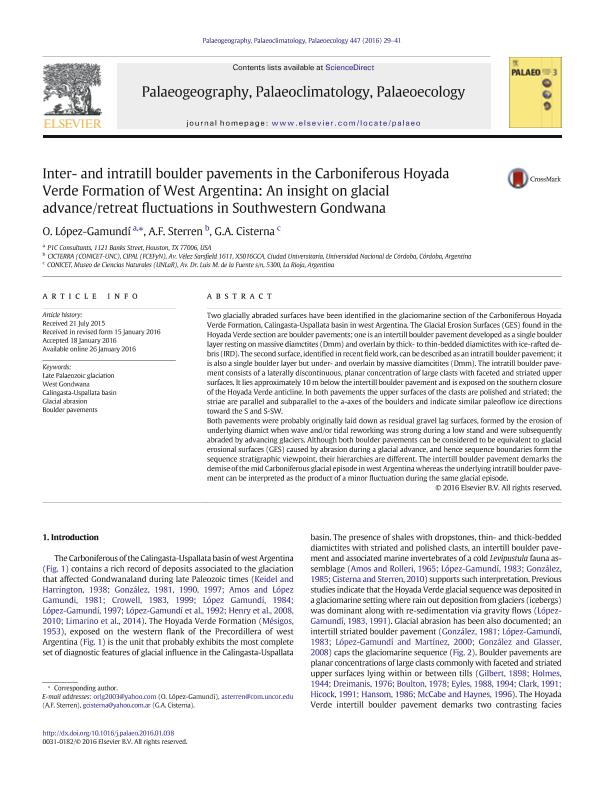Mostrar el registro sencillo del ítem
dc.contributor.author
López Gamundí, O
dc.contributor.author
Sterren, Andrea Fabiana

dc.contributor.author
Cisterna, Gabriela Adriana

dc.date.available
2018-04-18T18:28:27Z
dc.date.issued
2016-04
dc.identifier.citation
López Gamundí, O; Sterren, Andrea Fabiana; Cisterna, Gabriela Adriana; Inter- and intratill boulder pavements in the Carboniferous Hoyada Verde Formation of West Argentina: An insight on glacial advance/retreat fluctuations in Southwestern Gondwana; Elsevier Science; Palaeogeography, Palaeoclimatology, Palaeoecology; 447; 4-2016; 29-41
dc.identifier.issn
0031-0182
dc.identifier.uri
http://hdl.handle.net/11336/42511
dc.description.abstract
Two glacially abraded surfaces have been identified in the glaciomarine section of the Carboniferous Hoyada Verde Formation, Calingasta-Uspallata basin in west Argentina. The Glacial Erosion Surfaces (GES) found in the Hoyada Verde section are boulder pavements; one is an intertill boulder pavement developed as a single boulder layer resting on massive diamctites (Dmm) and overlain by thick- to thin-bedded diamictites with ice-rafted debris (IRD). The second surface, identified in recent field work, can be described as an intratill boulder pavement; it is also a single boulder layer but under- and overlain by massive diamcitites (Dmm). The intratill boulder pavement consists of a laterally discontinuous, planar concentration of large clasts with faceted and striated upper surfaces. It lies approximately 10mbelowthe intertill boulder pavement and is exposed on the southern closure of the Hoyada Verde anticline. In both pavements the upper surfaces of the clasts are polished and striated; thestriae are parallel and subparallel to the a-axes of the boulders and indicate similar paleoflow ice directions toward the S and S-SW. Both pavements were probably originally laid down as residual gravel lag surfaces, formed by the erosion of underlying diamict when wave and/or tidal reworking was strong during a low stand and were subsequently abraded by advancing glaciers. Although both boulder pavements can be considered to be equivalent to glacial erosional surfaces (GES) caused by abrasion during a glacial advance, and hence sequence boundaries form the sequence stratigraphic viewpoint, their hierarchies are different. The intertill boulder pavement demarks the demise of the mid Carboniferous glacial episode in west Argentinawhereas the underlying intratill boulder pavement can be interpreted as the product of a minor fluctuation during the same glacial episode.
dc.format
application/pdf
dc.language.iso
eng
dc.publisher
Elsevier Science

dc.rights
info:eu-repo/semantics/openAccess
dc.rights.uri
https://creativecommons.org/licenses/by-nc-sa/2.5/ar/
dc.subject
Late Palaeozoic Glaciation
dc.subject
West Gondwana
dc.subject
Calingasta-Uspallata Basin
dc.subject
Glacial Abrasion
dc.subject.classification
Meteorología y Ciencias Atmosféricas

dc.subject.classification
Ciencias de la Tierra y relacionadas con el Medio Ambiente

dc.subject.classification
CIENCIAS NATURALES Y EXACTAS

dc.title
Inter- and intratill boulder pavements in the Carboniferous Hoyada Verde Formation of West Argentina: An insight on glacial advance/retreat fluctuations in Southwestern Gondwana
dc.type
info:eu-repo/semantics/article
dc.type
info:ar-repo/semantics/artículo
dc.type
info:eu-repo/semantics/publishedVersion
dc.date.updated
2018-04-17T19:57:37Z
dc.journal.volume
447
dc.journal.pagination
29-41
dc.journal.pais
Países Bajos

dc.journal.ciudad
Amsterdam
dc.description.fil
Fil: López Gamundí, O. P1C Consultants; Estados Unidos
dc.description.fil
Fil: Sterren, Andrea Fabiana. Consejo Nacional de Investigaciones Científicas y Técnicas. Centro Científico Tecnológico Conicet - Córdoba. Centro de Investigaciones en Ciencias de la Tierra. Universidad Nacional de Córdoba. Facultad de Ciencias Exactas Físicas y Naturales. Centro de Investigaciones en Ciencias de la Tierra; Argentina
dc.description.fil
Fil: Cisterna, Gabriela Adriana. Universidad Nacional de La Rioja; Argentina. Consejo Nacional de Investigaciones Científicas y Técnicas; Argentina
dc.journal.title
Palaeogeography, Palaeoclimatology, Palaeoecology

dc.relation.alternativeid
info:eu-repo/semantics/altIdentifier/url/https://www.sciencedirect.com/science/article/pii/S0031018216000468
dc.relation.alternativeid
info:eu-repo/semantics/altIdentifier/doi/http://dx.doi.org/10.1016/j.palaeo.2016.01.038
Archivos asociados
